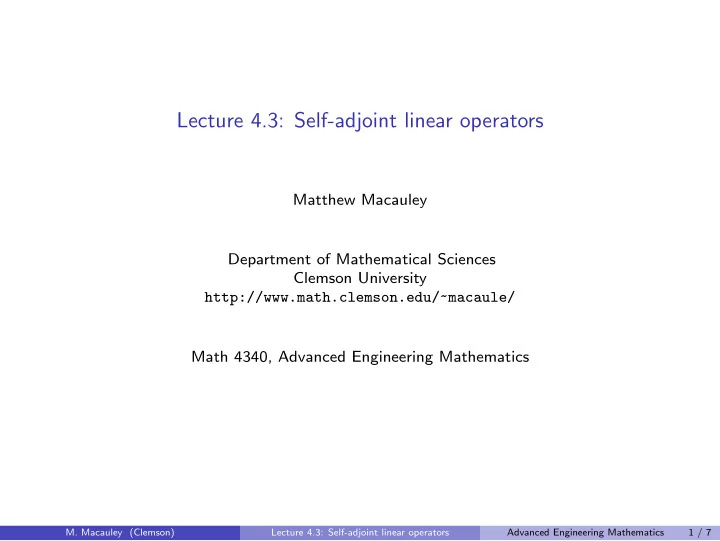

Lecture 4.3: Self-adjoint linear operators Matthew Macauley Department of Mathematical Sciences Clemson University http://www.math.clemson.edu/~macaule/ Math 4340, Advanced Engineering Mathematics M. Macauley (Clemson) Lecture 4.3: Self-adjoint linear operators Advanced Engineering Mathematics 1 / 7
Why self-adjoint operators are nice Definition Let V be a vector space with inner product �− , −� . A linear operator L : V → V is self-adjoint if � Lf , g � = � f , Lg � , for all f , g ∈ V . Theorem If L is a self-adjoint linear operator, then: (i) All eigenvalues of L are real. (ii) Eigenfunctions corresponding to distinct eigenvalues are orthogonal. Proof M. Macauley (Clemson) Lecture 4.3: Self-adjoint linear operators Advanced Engineering Mathematics 2 / 7
A one-variable example Remark The linear operator L = d 2 dx 2 = ∂ 2 x on the space C ∞ [0 , 1] is not self-adjoint. M. Macauley (Clemson) Lecture 4.3: Self-adjoint linear operators Advanced Engineering Mathematics 3 / 7
Dirichlet vs. Neumann boundary conditions Proposition The linear operator L = d 2 dx 2 = ∂ 2 x on either of the subspaces � � C ∞ f ∈ C ∞ [ a , b ] : f ( a ) = f ( b ) = 0 0 [ a , b ] := � � C ∞ f ∈ C ∞ [ a , b ] : f ′ ( a ) = f ′ ( b ) = 0 ⊥ [ a , b ] := is self-adjoint. M. Macauley (Clemson) Lecture 4.3: Self-adjoint linear operators Advanced Engineering Mathematics 4 / 7
Mixed boundary conditions Proposition The linear operator L = d 2 dx 2 = ∂ 2 x on the subspace � � C ∞ f ∈ C ∞ [ a , b ] : α 1 f ( a ) + α 2 f ′ ( a ) = 0 , β 1 f ( b ) + β 2 f ′ ( b ) = 0 α,β [ a , b ] := , where α 2 1 + α 2 2 > 0 and β 2 1 + β 2 2 > 0, is self-adjoint. M. Macauley (Clemson) Lecture 4.3: Self-adjoint linear operators Advanced Engineering Mathematics 5 / 7
A multivariate example Theorem Let R ⊂ R n be a bounded region with a smooth boundary B . Then the Laplacian operator n n ∂ 2 ∆ = ∇ 2 := � � ∂ 2 = x i ∂ x 2 i i =1 i =1 is self-adjoint on the space V = C ∞ 0 ( R ) of infinitely differentiable functions that vanish on B . The eigenfunctions of ∇ 2 are solutions to the PDE ∇ 2 f = λ f , called the Helmholtz equation. M. Macauley (Clemson) Lecture 4.3: Self-adjoint linear operators Advanced Engineering Mathematics 6 / 7
An example from quantum mechanics Definition The Hamiltonian is a self-adjoint operator, defined by H = − � 2 m ∇ 2 + V . This describes the energy of a particle of mass m in a real potential field V . The eigenfunctions ψ of H represent the stationary quantum states, and the eigenvalues E describe the energy levels of these states. They are solutions to the following PDE, called Schr¨ odinger equation: H ψ = E ψ. M. Macauley (Clemson) Lecture 4.3: Self-adjoint linear operators Advanced Engineering Mathematics 7 / 7
Recommend
More recommend